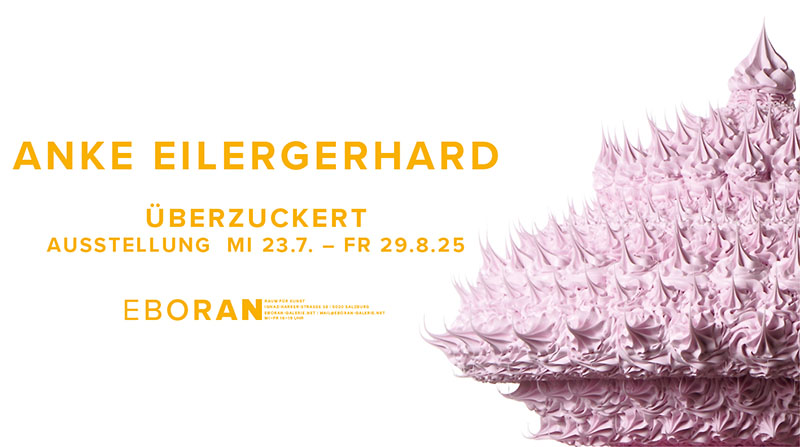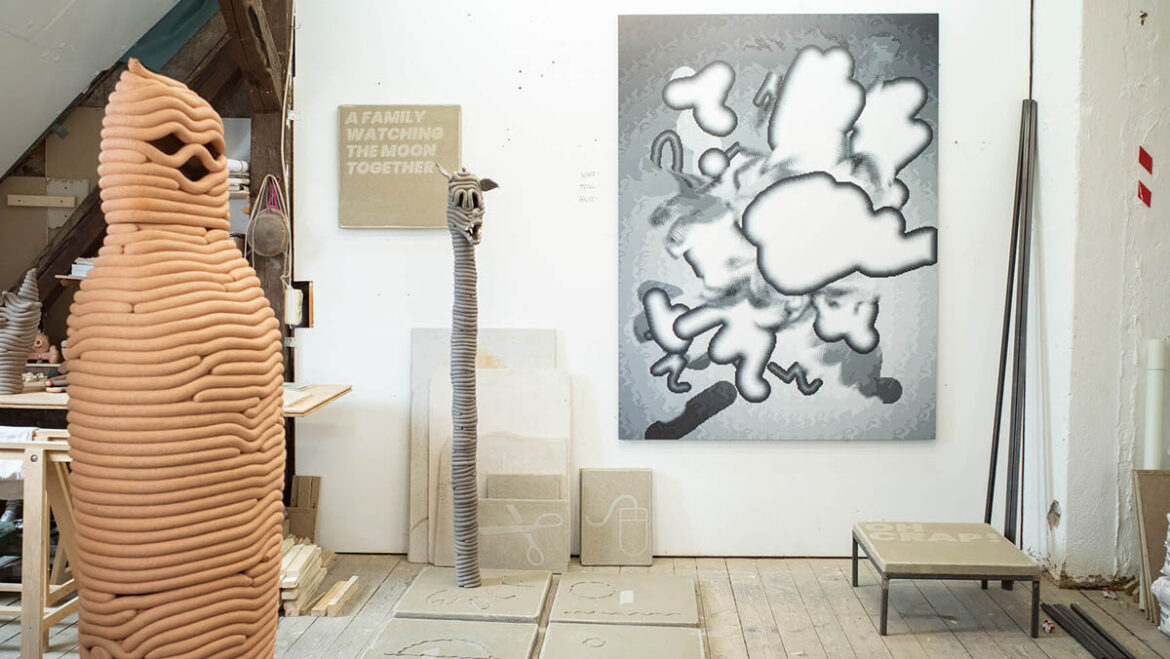
Er nimmt dabei nicht reine ästhetische Anleihen an Vorbilder aus Comic, Videospiel und Kunstgeschichte auf, sondern erschafft eine diffuse nostalgisch-melancholische Erinnerung an seine Sozialisation in den 90er Jahren, die nicht unbedingt ihn persönlich betrifft, sondern sich kollektiv übertragen lässt und uns mit Themen wie Vergänglichkeit auf humorvolle Weise konfrontiert.
Welche Themen faszinieren dich?
Ich beschäftige mich mit vielen unterschiedlichen Dingen. Was am Ende einen Platz in meiner Kunst findet, kristallisiert sich erst in meinem Arbeitsprozess heraus. Inzwischen kann ich ein Themenfeld überblicken, das sich für mich ganz natürlich aus meiner Arbeit heraus ergeben hat. Es beinhaltet häusliche Vorgänge, Symbole für Vergänglichkeit und Tod, die Sehnsucht nach Archaik und den Umgang mit dem Digitalen. Das Ganze ist immer von einer gewissen Ironie und Humor durchzogen, um mir selbst und Betrachter:innen einen eher leichten, spielerischen Zugang zu dann doch teilweise schweren Themen zu eröffnen.
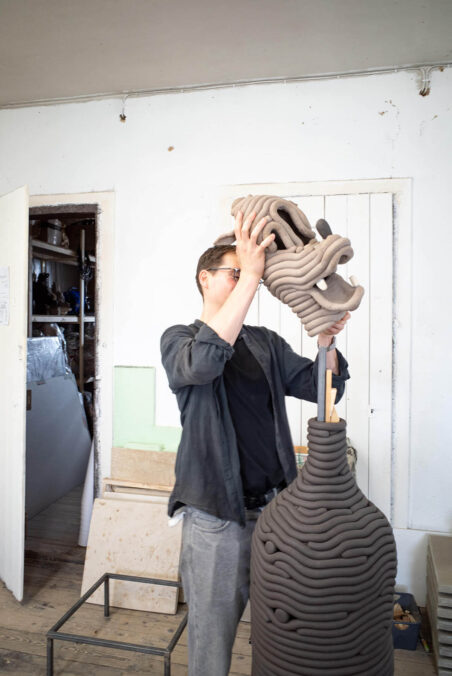
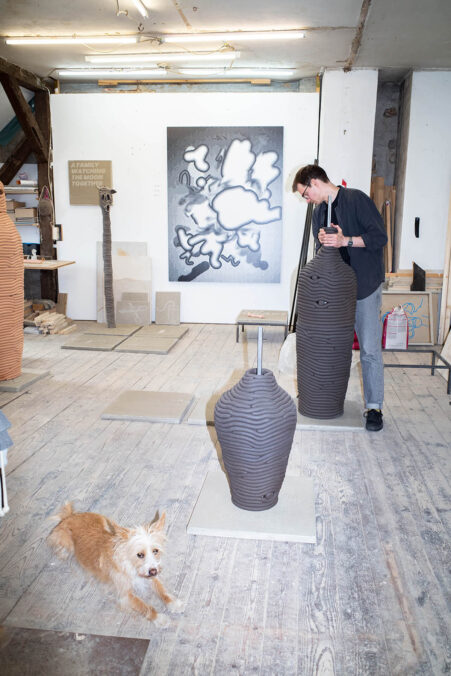
Ganz konkret tauchen in meinen Arbeiten immer wieder Hunde auf. Mich fasziniert die Verbindung zwischen Mensch und Hund, vor allem auch die Geschichte der gegenseitigen Domestizierung. Ohne den Menschen würde es ja keine Hunde in der heutigen Vielfalt und Form geben. Gleichzeitig gibt es in der zeitgenössischen Forschung auch den Blickwinkel, dass der Wolf den Menschen zu seinen Gunsten domestiziert hat. Gerade sind es vor allem Hunde und hundeähnliche Tiere aus dem Disney-Universum oder der Looney-Tunes, die mich beschäftigen. Das hat vor allem damit zu tun, dass ich in der sogenannten Wulst- oder Würstchentechnik, auf die ich meine keramischen Skulpturen reduziert habe, die typischen, großen, comichaften Augen entdeckt habe, die sich mir fast schon aufgedrängt haben. Gleichzeitig sind die so entstehenden Augenhöhlen leer und geben den Blick auf das hohle Innere der Skulpturen frei, was mich an Mumien oder Kokons erinnert. Grabstätten und –beilagen haben auch schon immer eine starke Faszination auf mich ausgeübt. Angefangen hat das aber mehr mit dem Interesse für die popkulturellen Verzerrungen davon, beispielsweise in Videospielen und Filmen. Gräber, Tempel und Ruinen sind dort ständig auftauchende Kulissen. Videospiele aus der Super-Nintendo-Ära waren auch zentral prägend für mein ästhetisches Verständnis. Später hat sich diese Faszination dann auf die Kunstgeschichte ausgeweitet. Ich finde es aber irgendwie lustig, dass ich zuerst die Referenz der Referenz konsumiert habe.
Was mich an Videospielen und Comics momentan interessiert, sind Bilder und Kunstwerke, die dort irgendwo im Hintergrund hängen oder stehen. Diese Illustration von Kunst und auch das Umgehen mit der eigenen Autorenschaft bereiten mir Freude und finden sich teilweise auch in meinen Arbeiten wieder. So habe ich mir in meiner letzten Serie digitaler Malerei vorgestellt, dass die Bilder aus einem fiktiven Videospiel stammen könnten, das ich selbst aber nicht kenne. So schaffe ich zwischen mir und der Sache, an der ich arbeite, eine Distanz, die ich als befreiend empfinde.
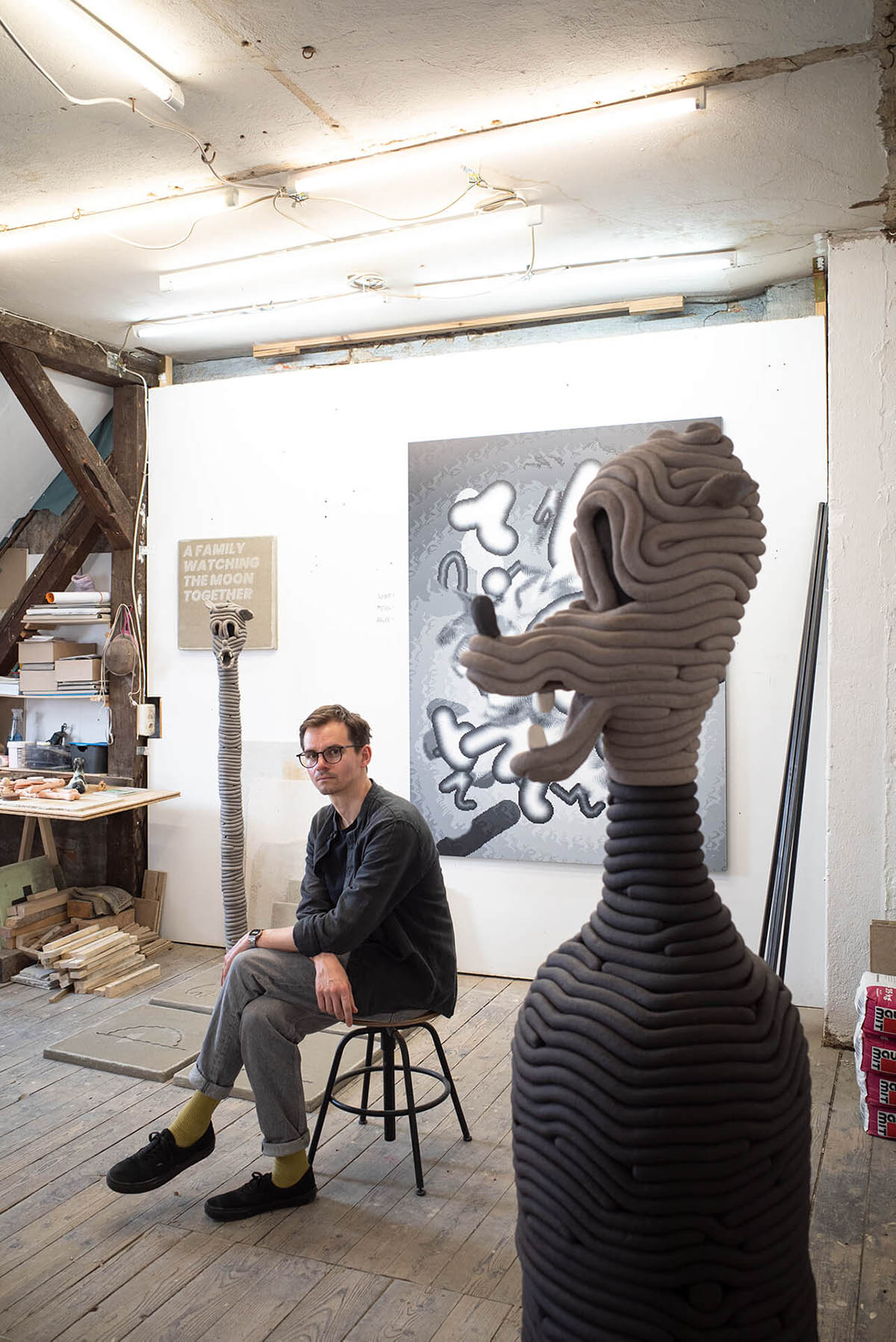
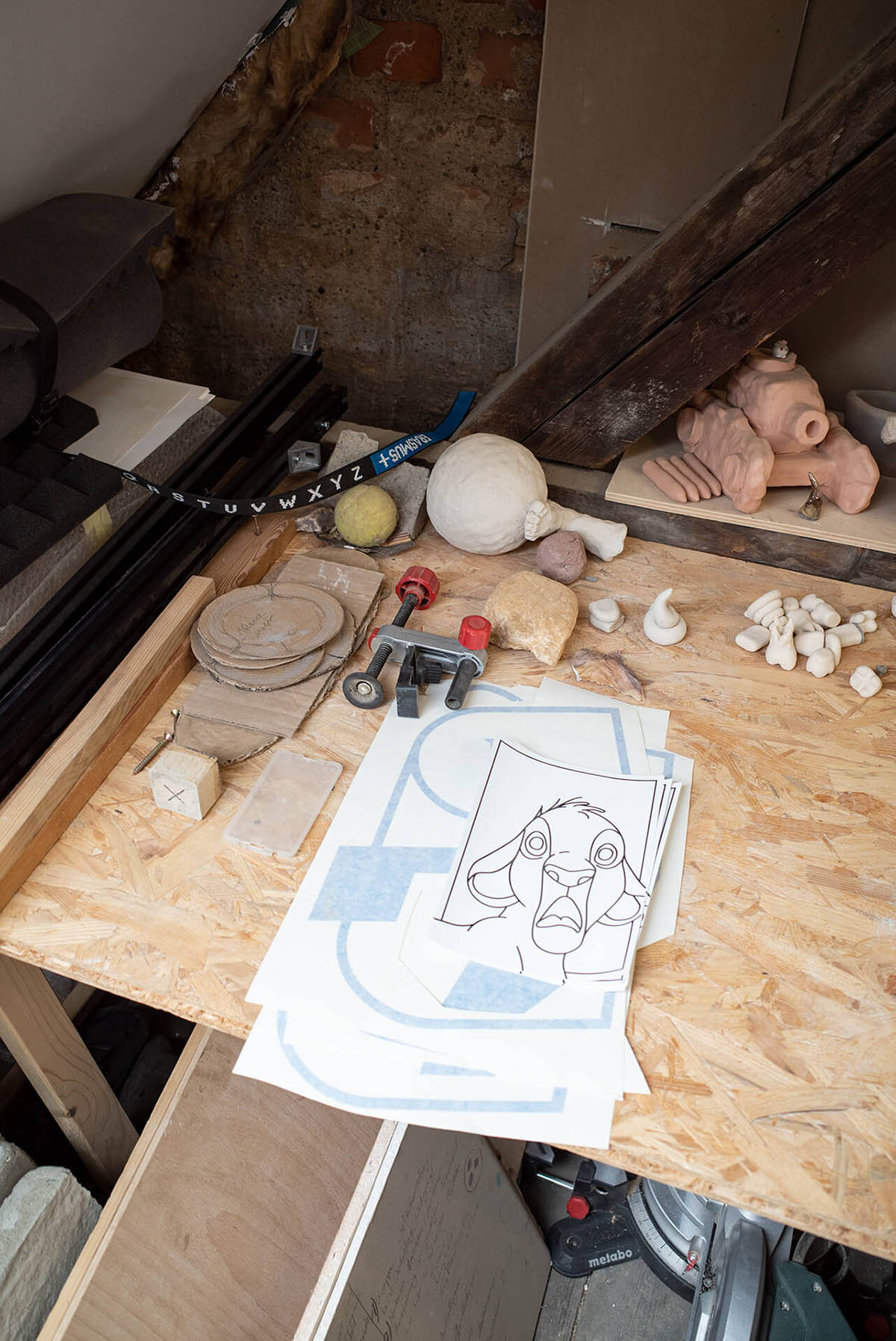
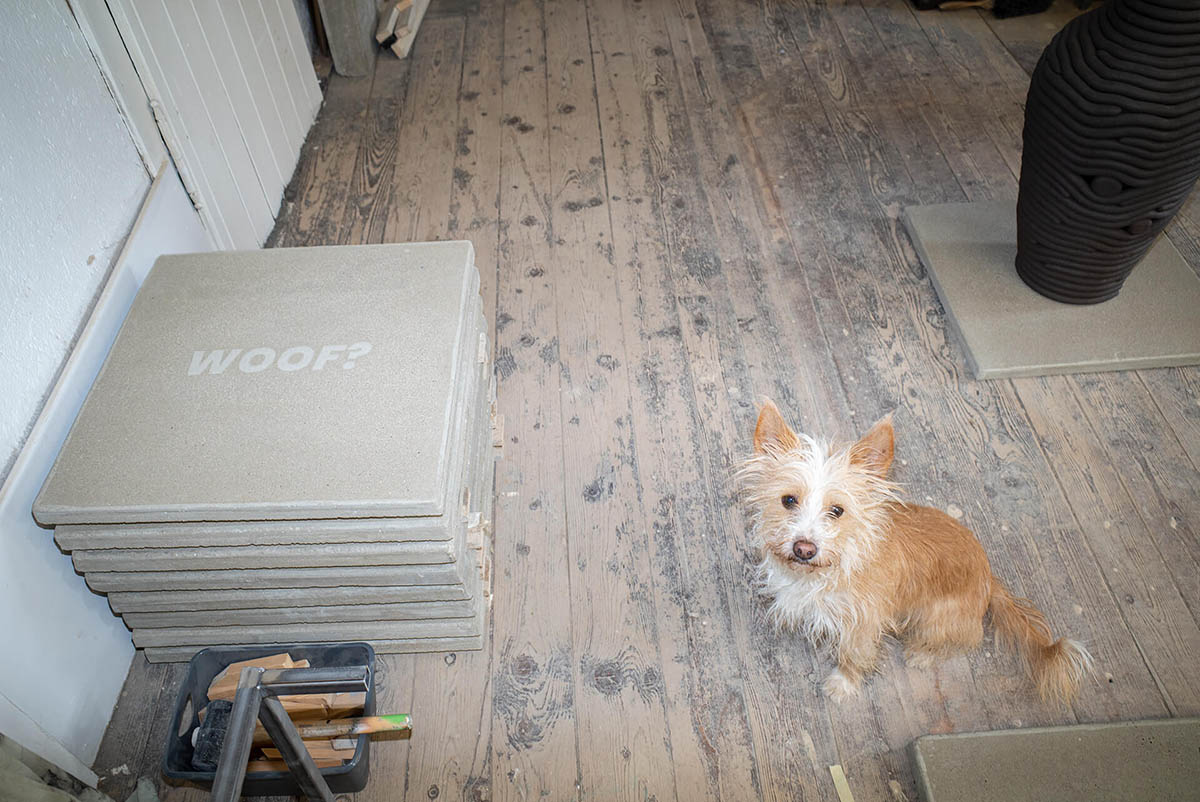
Welche Einflüsse prägen deine Arbeiten?
Ich bin immer auf der Suche nach Motiven, die in mir vage Assoziationen oder Dejà-vus auslösen. Oft kann ich das erst gar nicht konkret zuordnen, sondern halte mich vorerst nur in diesen unbestimmten Atmosphären, die etwas in mir auslösen, auf. Im Laufe meines Arbeitsprozesses sehe ich dann, wo bestimmte Bildideen herkommen. Manchmal ist das etwas subtiler und manchmal wird dann bewusst plakativ gesetzt.
Ich kann sagen, dass mich zeitliche Verzerrungen und intergenerationale Transformationen von Bildern interessieren, wobei ich mich selbst als Teil und Beobachter des Prozesses sehe. Schon immer senden Menschen in Form ihres kulturellen Schaffens Bilder aus, rezipieren und verändern diese und geben sie weiter. Heute ist das durch unsere überbordende Popkultur und das Internet natürlich auf die Spitze getrieben. Welche Motive ich dann auswähle, hängt davon ab, ob diese etwas Weiteres, „Über-sich-hinausweisendes“ in mir auslösen. Oft ist diese Atmosphäre, die ich suche, eine Verschmelzung von Humor und Melancholie. Beispielsweise liebe ich die Bruder-Klaus-Feldkapelle von Peter Zumthor. In meinen Arbeiten kommt Goofy dann als Pilgerer dorthin. Dieses Bild weckt beispielsweise eine bestimmte Atmosphäre von Vergänglichkeit und Humor in mir, die mir Spaß macht.
Als prägend für meine Arbeitsweise empfinde ich aber auch mein Studium der Malerei, welches ich später durch ein Studium in der Medienkunst erweitert habe. Aus der Malerei, die inzwischen fast vollständig aus meinen Arbeiten verschwunden ist, stammt bei mir ein mehr prozesshaftes Denken, welches sich mit einem stärker das Medium und den Inhalt hinterfragenden Ansatz aus der Medienkunst verbunden hat. Beides empfinde ich als sehr bereichernd für meine Arbeiten.
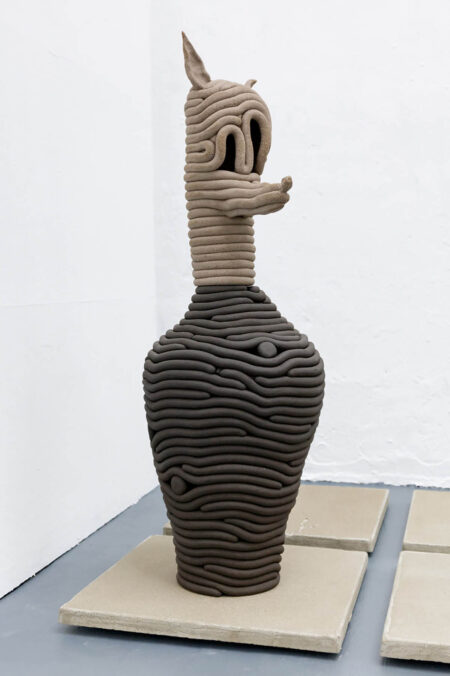

Was macht für dich die Verwendung von Materialien wie Keramik oder anderen Objekten in deiner Kunst so besonders?
Keramik fasziniert mich durch ihre unterschiedlichen stofflichen Zustände. Zunächst ist Ton sehr flexibel und organisch. Aber durch das Trocknen und Brennen erstarrt alles zu einer steinartigen Haptik. Kontraste und Spannungsfelder ziehen sich schon lange durch meine Arbeiten. In der Keramik selbst sehe ich bereits einen Kontrast. Gleichzeitig mag ich auch, dass das Material sehr eigensinnig ist und mich dazu zwingt, auf es einzugehen. Überhaupt bin ich in den letzten Jahren mit ständiger Reduktion und dem Schaffen von Rahmenbedingungen für meine Arbeitsweise beschäftigt. Wie ich meine Grafiken auf einzelne Pixel reduziert habe, habe ich für mich die Keramik auf die sogenannte Wulst- oder Würstchentechnik reduziert. Auch auf Glasuren verzichte ich inzwischen vollständig. Die farbige Gestaltung findet rein durch die Verwendung von unterschiedlichen Tonen statt. Die einzelnen Wülste, aus denen ich Skulpturen aufbaue, drehe ich von Hand. Das gibt mir ein ganz gutes Gefühl fürs Material und im Vergleich zum 3-D-Druck, der ja meistens mit derselben Technik arbeitet, kann ich direkt mit dem Material spielen. So ergaben sich dann auch die comichaften, großen Augen ganz natürlich aus meinem Arbeitsprozess. Keramik strahlt ja etwas Archaisches und „Veraltetes“ aus. In Verbindung mit zeitgenössischen, industriellen Materialien entsteht etwas, was mich sehr anspricht. Diese weiteren Materialien sind in meinem Fall vor allem Beton, Metall und Prints auf Acrylglas oder Hartschaumplatten.
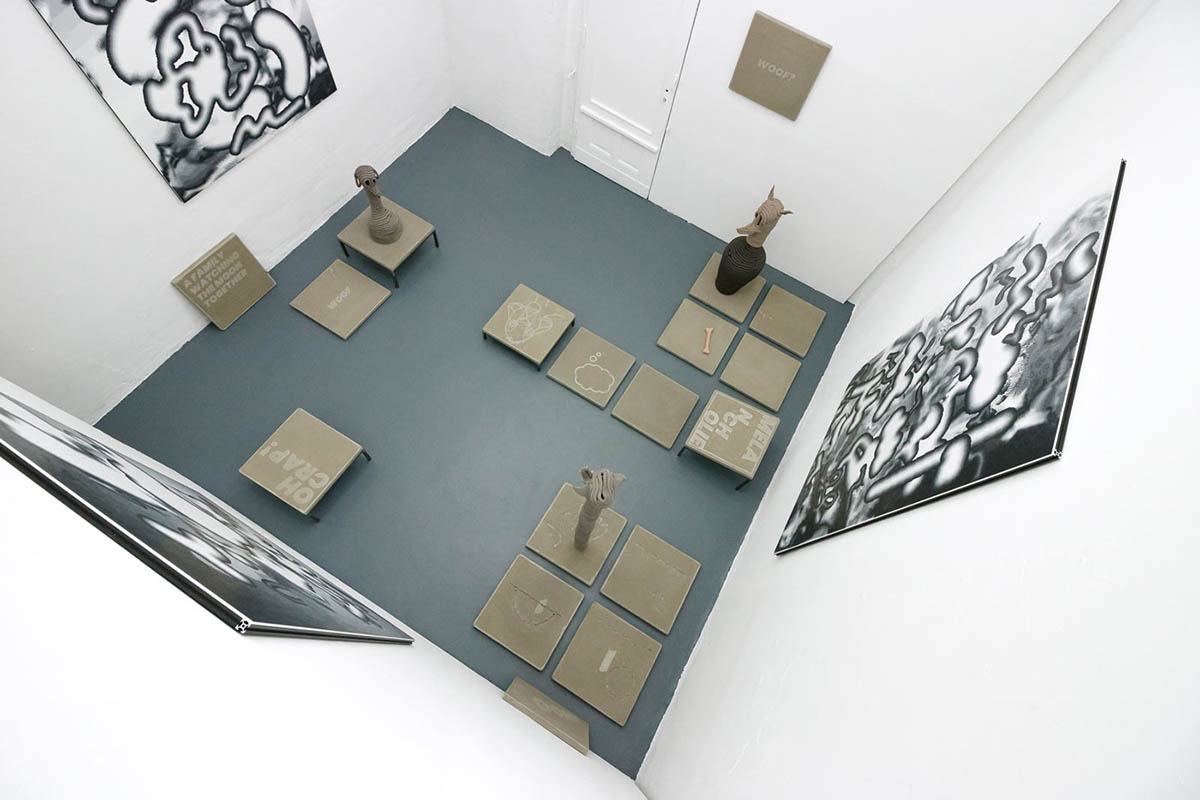
Wie siehst du das Verhältnis zwischen digitaler Kunst und physischen Materialien?
Plakativ gesagt steht das Digitale bei mir für geistige und kognitive Vorgänge und physisches Arbeiten für eine mehr körperliche Auseinandersetzung. Was ich am digitalen Arbeiten schätze, ist, dass man nicht an physikalische Gegebenheiten gebunden ist. Daraus ergibt sich für mich aber gleichzeitig die größte Schwierigkeit: Die Frage danach, wie Digitales in die reale Welt übersetzt werden kann. Es gibt auf jeden Fall eine gewisse Spannung zwischen dem Digitalen und dem Physischen. Das Digitale ist auch immer sehr clean und sauber. Da in der digitalen Welt kein Dreck eingeplant ist, sind Prints und Screens immer sehr anfällig für Kratzer und Beschädigungen, was in mir Stress auslöst. Das versuche ich aber wiederum zu nutzen. In manchen meiner Arbeiten treffen so bedruckte Acrylglasplatten direkt auf Objekte aus Keramik, was immer einen sehr starken materiellen Unterschied ausstrahlt. Durch meine Motive und Techniken versuche ich aber dazwischen, wiederzuvermitteln, und suche nach Überschneidung. So stellt Keramik beispielsweise eine rudimentäre Form des kulturellen Schaffens selbst dar, so wie die Pixel-Grafiken, auf die ich mich beziehe, Teil einer rudimentären digitalen Welt sind. Die sogenannte digitale Welt ist aber auch immer in die reale Welt eingebettet. Beispielsweise ist das Spielen von Videospielen auch zwangsweise eine Handlung, die an einem Ort stattfindet, was den Zusammenhang mit dem Häuslichen in meinen Themenfeldern vielleicht auch erklärt. Deswegen sehe ich in meiner Arbeit auch nicht unbedingt eine konkrete Grenze zwischen dem Digitalen und dem Physischen.
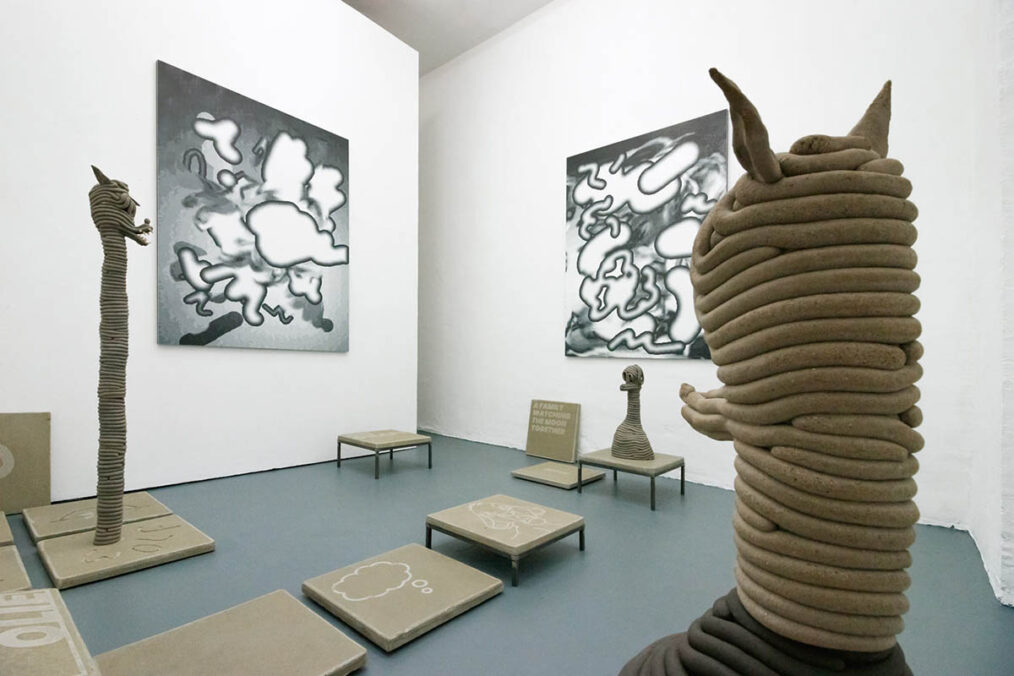
Welche Verantwortung oder Rolle hat Kunst?
Kunst sehe ich vor allem als Versuch der menschlichen Kommunikation. Es werden mit ihr Inhalte verhandelt, die man mit der gesprochenen Sprache vielleicht nicht in ihrer Ganzheit erfassen kann. Ich sehe da aber keine Hierarchie. Schrift und Bild haben beide ihre eigene Logik. Ich denke, dass Kunst vor allem die Verantwortung hat, sich selbst zu reflektieren. Egal wie ein künstlerischer Prozess aussieht und mit welchen Medien man arbeitet, sind die Selbstreflexion und Hinterfragung von dem, was man da macht, ausschlaggebend. Im besten Falle wird das dann in die Welt transportiert und hinterlässt seine Spuren. Das sollte meiner Meinung nach aber ohne moralische Vorstellungen oder didaktische Allüren passieren.
Was sind die Dinge, die dich im Leben am glücklichsten machen?
Meine Freundin, meine Freunde und unser Hund. Sich in der Natur aufhalten und Sport sind gute Sachen fürs Glücksempfinden. Sonst auch noch Kunst zu schaffen. Aber vor allem auch mit dieser in die Öffentlichkeit zu treten. Kunst zu machen, ohne diese in Diskurs zu bringen, würde mich nicht ausfüllen.

Welche Pläne hast du für den Sommer? Gibt es etwas, das du unbedingt machen möchtest?
Erstmal habe ich wieder etwas Zeit fürs Studio, worauf ich mich sehr freue. Mit einem Kollegen kuratiere ich eine Gruppenausstellung in Leipzig im September. Das wird mich noch vor allem über den Sommer beschäftigen. Im September nach der Eröffnung habe ich dann Zeit für meinen diesjährigen Urlaub. Wir fahren nach Italien zum Wandern in den Alpen und Freunde in Mailand besuchen. Darauf freue ich mich sehr.
Woran arbeitest du gerade? Sind Ausstellungen in Planung?
Ich hatte gerade eine Einzelausstellung in der Kunsthalle.Ost in Leipzig. Da konnte ich für mich in meinen Arbeiten einiges klären und auf einen Punkt bringen. Der kleine, aber für Ausstellungen sehr dankbare Raum ohne Fenster mit ausschließlich weißen, planen Wänden hat sich mir sehr gut dafür angeboten, eine kompakte Präsentation zu entwickeln. Darauf aufbauend werde ich jetzt an neuen Skulpturen und Objekten im Atelier arbeiten. Geplant sind weiterhin unterschiedliche Gruppenausstellungen und eine Duo-Show im nächsten Jahr, auf die ich mich besonders freue, da wir als loses Thema ein Videospiel referieren werden, das mich und den anderen Künstler geprägt hat und wir in unseren Arbeiten immer wieder Einflüsse daraus entdecken können. Auf die Ergebnisse bin ich schon sehr gespannt.
Markus Heller – www.markus-heller.net, www.instagram.com/markus.heller



